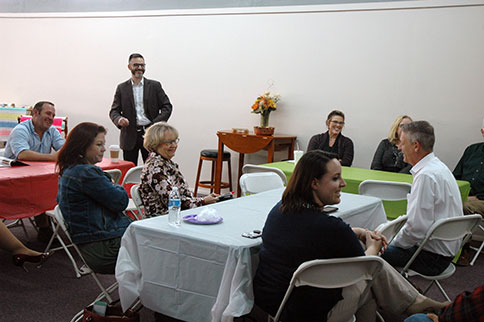
A January 23 meeting with the man who is charged with devising a plan for revitalizing downtown Atmore started out as a forum for local and area artists and artisans to provide input on how to make the arts a major part of that plan.
But even with several creative individuals taking part, the meeting — held at Main Street Gallery — morphed back and forth into a discussion of some of the project’s non-artistic goals.
“This is all part of creative placemaking,” said Foster Kizer, a member of the Pride of Atmore Committee, the driving force behind the effort to restore downtown, during his introduction of Zack Mannheimer. “Zack is trying to help us restore the (Strand) theater and revitalize downtown Atmore, He’s the go-to guy, the one who is collecting our ideas and hopefully taking this enthusiasm, putting it on paper and coming up with a program that we can use to bring Atmore’s downtown back.”
Mannheimer, a certified community planner who was visiting Atmore for the second time to gather opinions and data, said the key to the plan is reconciling the needs and wants of the various age groups who might take advantage of a “new” downtown.
“What it really boils down to is how do you make a downtown that is vibrant, that makes people want to stay,” he said. “People from age eighteen to thirty-five and people age fifth-five and up want pretty much the same thing, they just want it at a different time. Everybody wants to go downtown and have a really good meal, maybe see some live music, go to a show or an art gallery or have a nice walk in a downtown with great retail and public spaces. Some want to do it before eight at night; some want to do it from nine p.m. until one in the morning.
“My job is to figure out how to foster all that and put the business plan behind me so it can actually be sustained.”
When the talk did focus on art, the main complaint was the lack of studio space in which artists and craftspeople can create and display their works.
Mannheimer explained that a vital component of the preliminary plan is to not only restore the Strand to a degree of its former glory, but to utilize the properties on each side of the theater as well. He agreed that culture and art are key pieces of the revitalization puzzle, but said there has to be some type of financial consideration given, even to artistic endeavors.
He pointed out that plans to turn Main Street Gallery into a sort of “artist’s mall” are promising, but pointed out that such a venture might or might not be financially feasible.
“It’s great if we say we’re going to have a four-thousand square-foot gallery space in downtown Atmore,” Mannheimer said. “That would be awesome, but would it work financially? I don’t know. My job is to take all these ideas and figure out how to make them work.”
Discussion carried over into the possibility of using some of the space in the buildings adjacent to the theater as studio space or as classroom space for artistic instruction. There was also talk of a rotating artist-in-residence program.
“There could be classroom spaces for instruction in the arts, maybe a dance studio that doubles as a studio for yoga, Pilates, anything like that,” he explained.
“Space could be dedicated to other art forms, like ceramics, pottery, sculpture, painting, photography or jewelry-making. There could even be an after-school arts program.”
Mannheimer said the main thrust of his preliminary planning stems from suggestions he has received from city officials, local business owners and others.
Among the highlighted portions of the preliminary plan area micro-brewery, an ice cream and pizza parlor, a live music venue and a facility that could be rented for wedding receptions, birthday parties and similar events.
Then he announced his projection of the price tag that would accompany the plan as it now stands, a plan that could be reshaped as the project progresses. He also pointed out that there is no guarantee that such a plan will meet success.
“To do all I’ve talked about today it’s going to cost seven million dollars,” he said. “My job is to figure out where that money comes from. I believe it can be found, but I can’t tell you where today. I don’t know if all the stuff I’m talking about will work, but I believe most if it will work. Some of the things we’ve talked about won’t work, and they’ll have to be replaced.
“I don’t know if you’ll be successful, but I believe you will be.”
